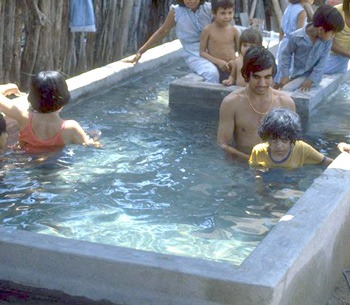Hesperian Health Guides
Designs for Therapy Baths
Floating and playing in water provide exercise and therapy for many kinds of physical disabilities—especially those in which movement is limited because of pain or muscle spasms.

 |
| For children who have the opportunity, bathing, swimming, and playing in rivers and ponds with other children is good—but only when the rivers or pools are not dangerous and do not transmit diseases. |
 |
| This "therapy pool" at PROJIMO has one large deep tank for standing, swimming, and play. And it has 2 narrow ‘water lanes’ at different depths for children to learn to walk while supported by water. Children with and without disabilities play here together. |
TUBS OR TANKS OF SUN-HEATED WATER (solar heating)
| Bathing in warm water is especially helpful. The penetrating heat of the water helps to improve blood flow, calm pain, and relax the muscles. |
 sheet of strong, black plastic
layer of sand or soft mud (or use cement) | |
| You can dig a hole in the ground and cover its sides with plastic sheets or cement to prevent the water from leaking out. So that the sunlight heats the water faster, use black plastic, or paint the cement a dark color. (Green is friendlier than black.) |  |
A sheet of clear (see-through) plastic stretched over the water when not in use will make it heat faster in the sunlight. |
TUB WITH A SELF-CIRCULATING SUN HEATER

In order for the water to keep flowing, the hose heating unit must be below the level of the tub.
Because warm water weighs less than cool water, the hot sun-heated water will rise and run into the tank here.
The cooler water will run out here.
black hose
sheet of clear plastic over the hose
This page was updated:04 Apr 2024


